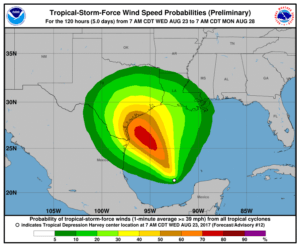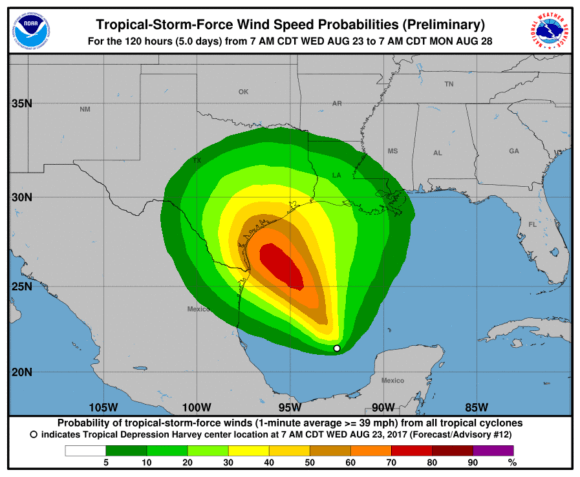The National Hurricane Center has issued a storm surge watch for Texas coast from Port Mansfield to High Island and a hurricane watch from north of Port Mansfield to San Luis Pass.
The government of Mexican government also issued tropical storm watch for the coast of Mexico from Boca De Catan to the mouth of the Rio Grande.
The watches were issued for Tropical Depression Harvey, which the NHC said should reach the Texas coast by late Friday. It is expected to become a hurricane by the time it makes landfall.
Maximum sustained winds currently are near 35 mph (55 km/h) with higher gusts and strengthening is forecast during the next 48 hours.

A storm surge watch means there is a possibility of life- threatening inundation, from rising water moving inland from the coastline, in the indicated locations during the next 48 hours.
A hurricane watch means that hurricane conditions are possible within the watch area. A watch is typically issued 48 hours before the anticipated first occurrence of tropical-storm-force winds, conditions that make outside preparations difficult or dangerous.
Interests in southwestern Louisiana should also monitor the progress of this system for possible watches this afternoon, the NHC said.
Harvey is expected to produce total rain accumulations of 10 to 15 inches with isolated maximum amounts of 20 inches over the middle and upper Texas coast and southwest Louisiana through next Tuesday, with heavy rainfall beginning as early as Friday morning.
Harvey is also expected to produce total rain accumulations of 3 to 9 inches in portions of south, central, and northeast Texas and the rest of the lower Mississippi Valley. Rainfall from Harvey could cause life-threatening flooding.
The combination of a dangerous storm surge and the tide will cause normally dry areas near the coast to be flooded by rising waters moving inland from the shoreline.
The deepest water will occur along the immediate coast near and to the northeast of the landfall location, where the surge will be accompanied by large and destructive waves. Surge-related flooding depends on the relative timing of the surge and the tidal cycle, and can vary greatly over short distances.
Source: National Hurricane Center
Topics Catastrophe Natural Disasters Texas Windstorm Hurricane
Was this article valuable?
Here are more articles you may enjoy.



 Aon Extends Employment Agreement With CEO Case
Aon Extends Employment Agreement With CEO Case  Howden Buys M&A Insurance Broker Atlantic Group in US Expansion
Howden Buys M&A Insurance Broker Atlantic Group in US Expansion  ’60 Minutes’ Homeowners Ask Court to Force DFS to Divulge Heritage Probe Info
’60 Minutes’ Homeowners Ask Court to Force DFS to Divulge Heritage Probe Info  Cloudy Future for Bourbon Has Jim Beam Closing Distillery for a Year
Cloudy Future for Bourbon Has Jim Beam Closing Distillery for a Year 

